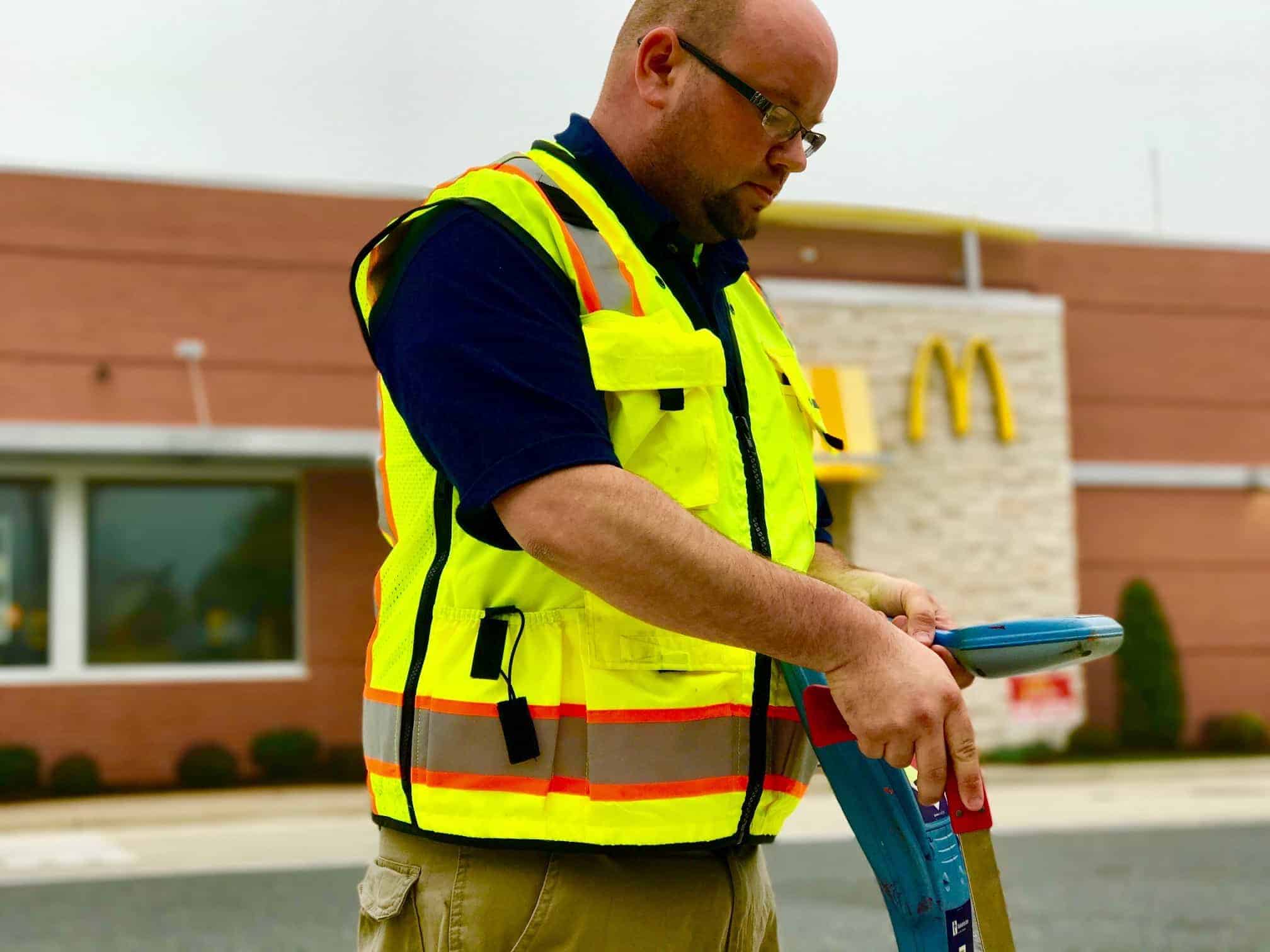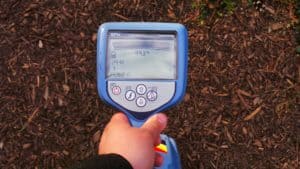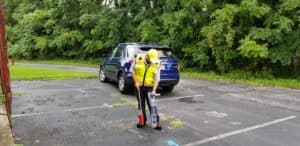What does electromagnetic mean for utility locating?

There are several technologies for underground utility locating companies to utilize when searching for subsurface utilities, and electromagnetic equipment is the most common, and in most scenarios the most effective.
How does electromagnetic equipment work?
Electromagnetic equipment works by detecting the magnetic field around a utility system that is produced by a radio frequency. The radio frequency can be naturally occurring or induced with the use of a transmitting device. Detecting naturally occurring frequencies, such as 60mHz in the USA and 50mHz overseas is known as Passive Locating. When we introduce a programmed and controlled frequency using a transmitter, that is known as Active Locating.
Passive Utility Locating
 Locating a utilities naturally occurring frequencies can be an effective method to identify if a utility conflict exists, however, it is the least accurate method and can lead to mis-marked and misidentified utilities. Electric cables are the most common utility that can be detected using passive utility locating methods, but many other utilities will emit a 60Mhz frequency as well. Cable TV, large copper telephone lines, steam, and even some water pipes can also transmit this frequency. When you don’t control the frequency you are detecting, you can’t isolate the target utility and positively identify it.
Locating a utilities naturally occurring frequencies can be an effective method to identify if a utility conflict exists, however, it is the least accurate method and can lead to mis-marked and misidentified utilities. Electric cables are the most common utility that can be detected using passive utility locating methods, but many other utilities will emit a 60Mhz frequency as well. Cable TV, large copper telephone lines, steam, and even some water pipes can also transmit this frequency. When you don’t control the frequency you are detecting, you can’t isolate the target utility and positively identify it.
Performing a grid scan throughout a project area using passive frequency detection is a great way to identify possible utility conflicts, however when it comes to locating the utility with paint and flags, we suggest an active approach.
Active Utility Locating
Applying a known and controlled radio frequency to a utility system is known as Active Locating. It allows the technician to control the application method, frequency, connection point, and ground location. These are key elements needed to isolate target utilities for positive identification. Application methods refers to how the signal is applied to the underground utility. There are 2 methods: Direct and Induction.
Direct Method of Active Locating
 The direct connection method is the most reliable method to locate underground utilities. It works by applying the locating frequency directly to the target utility using a wire or lead cable and clip. The transmitting device is then grounded, preferably to an isolated ground bar that isn’t connected or bonded to another utility. Using a ground wire or grounding bar that is bonded to another utility will provide the frequency with an excellent return path, and could lead to mis-marking your target utility. The direct connection method of active locating can be used on a variety of pipes and cables where the conductive portion of the underground utility can be accessed, such as fire hydrants, splice cabinets, meters, or grounded light poles, etc.
The direct connection method is the most reliable method to locate underground utilities. It works by applying the locating frequency directly to the target utility using a wire or lead cable and clip. The transmitting device is then grounded, preferably to an isolated ground bar that isn’t connected or bonded to another utility. Using a ground wire or grounding bar that is bonded to another utility will provide the frequency with an excellent return path, and could lead to mis-marking your target utility. The direct connection method of active locating can be used on a variety of pipes and cables where the conductive portion of the underground utility can be accessed, such as fire hydrants, splice cabinets, meters, or grounded light poles, etc.
Induction Method of Active Locating
There are two ways to apply an active signal using induction in lieu of directly connecting to a conductor. The more reliable method of inducing an active signal is by using what is called an inductive clamp. This is a clamp that concentrates the broadcast of the radio frequency in a targeted area, usually around a cable, conduit, or smaller diameter pipe. The least reliable method is generally referred to as “drop box” because it involves placing the transmitting device on the surface of the ground to broadcast the radio frequency in a large area in the vicinity of the target conductor. This can be problematic of course because the frequency will transmit through anything in the vicinity of the transmitter, not just the intended utility. The drop box method of active locating is the last resort when no connection to the utility is possible, and should be used with extreme caution.
 A device known as a “split box” is used to aid in the detection of underground utilities. The device works by broadcasting an active frequency into the ground. When the signal is transmitted through a pipe, cable, or structure a peak reading is detected by the receiver device. This is another example of the inductive method of active locating.
A device known as a “split box” is used to aid in the detection of underground utilities. The device works by broadcasting an active frequency into the ground. When the signal is transmitted through a pipe, cable, or structure a peak reading is detected by the receiver device. This is another example of the inductive method of active locating.
Benefits of Active Locating
 A known and pre-programmed radio frequency traveling down a conductor will produce a magnetic field that can be detected on the surface using a receiver device. The benefit in using an active signal over a passive signal is that we have better control over the signal. We can control the frequency level, power output, application method, and of course the application site on the conductor. This gives underground utility locators the edge over using passive signals, which we have no control over. Using active utility locating methods with electromagnetic methods you can:
A known and pre-programmed radio frequency traveling down a conductor will produce a magnetic field that can be detected on the surface using a receiver device. The benefit in using an active signal over a passive signal is that we have better control over the signal. We can control the frequency level, power output, application method, and of course the application site on the conductor. This gives underground utility locators the edge over using passive signals, which we have no control over. Using active utility locating methods with electromagnetic methods you can:
- Adjust the frequency from low, medium, or high frequencies
- Adjust the power output of the transmitting device
- Control the grounding location of the transmitter
- Control the connection point of the transmitter
How is Passive Locating Helpful?
For a private utility locating company like Utility Locator LLC, passive locating is a critical method we use to help identify potential conflicts. Unlike most Call 811 locators, we mark everything we can find for your protection. We use passive locating scans to help alert us when a potential conflict might exist. Rarely will we use the active signal to perform the utility locating service, however, we use the signal detection as a sort of alarm that there is something present that needs further investigation.

Leave a Reply
You must be logged in to post a comment.